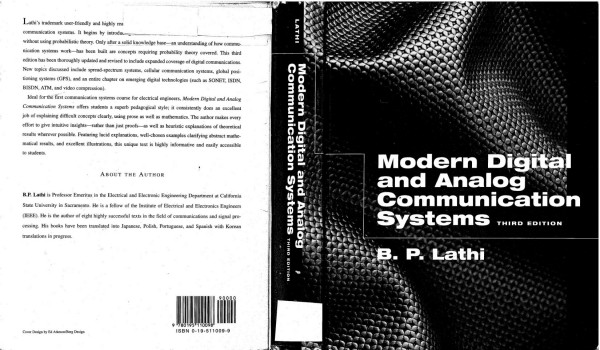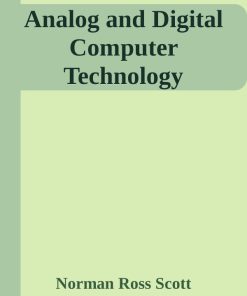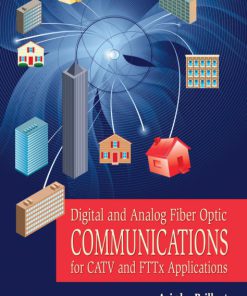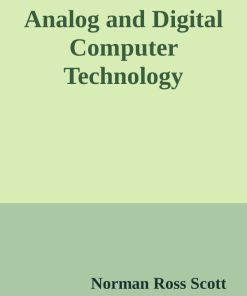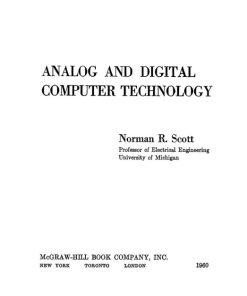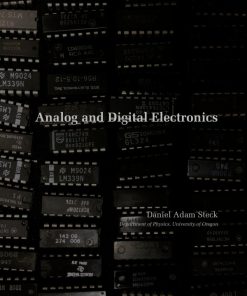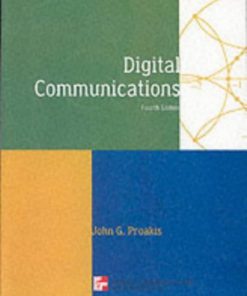Modern Electrical Communications Analog Digital and Optical Systems 1st edition by Henry Stark, Franz Tuteur, John Anderson ISBN 0135931126 978-0135931127
$50.00 Original price was: $50.00.$25.00Current price is: $25.00.
Authors:Henry Stark; Franz B. Tuteur; John B. Anderson , Series:Electrical Engineering [34] , Tags:Technology & Engineering; General , Author sort:Stark, Henry & Tuteur, Franz B. & Anderson, John B. , Ids:9780135931127 , Languages:Languages:eng , Published:Published:Sep 1988 , Publisher:Prentice-Hall , Comments:Comments:New edition of a textbook at senior/graduate level.
Modern Electrical Communications: Analog, Digital, and Optical Systems 1st edition by Henry Stark, Franz Tuteur, John Anderson – Ebook PDF Instant Download/Delivery. 0135931126 978-0135931127
Full download Modern Electrical Communications: Analog, Digital, and Optical Systems 1st edition after payment

Product details:
ISBN 10: 0135931126
ISBN 13: 978-0135931127
Author: Henry Stark, Franz Tuteur, John Anderson
This book serves as an essential resource for students, engineers, and professionals in the fields of electrical engineering, communications, and network systems. It systematically explains both the theoretical and practical aspects of communication technologies, emphasizing their applications in real-world scenarios.
Modern Electrical Communications: Analog, Digital, and Optical Systems 1st Table of contents:
Preface
- Overview of the Book
- Motivation and Scope
- Intended Audience
- Acknowledgments
Chapter 1: Introduction to Communication Systems
1.1. The Evolution of Communication Systems
1.2. Communication Models and Components
1.3. Analog, Digital, and Optical Communication Overview
1.4. Basic Communication System Elements: Transmitters, Receivers, and Channels
1.5. Types of Signals and Modulation Techniques
1.6. Noise and Interference in Communication Systems
Chapter 2: Analog Communication Systems
2.1. Analog Signal Representation
2.2. Amplitude Modulation (AM) and Demodulation
2.3. Frequency Modulation (FM) and Demodulation
2.4. Phase Modulation (PM)
2.5. Multiplexing Techniques: FDM and TDM
2.6. Noise Analysis in Analog Communication
2.7. Radio Wave Propagation and Link Budget
Chapter 3: Digital Communication Systems
3.1. Basics of Digital Communications
3.2. Digital Signal Representation and Sampling
3.3. Pulse Code Modulation (PCM)
3.4. Modulation Techniques: ASK, FSK, PSK
3.5. Channel Encoding and Error Correction
3.6. Digital Modulation Schemes: QAM, OFDM
3.7. Bandwidth Efficiency and Data Rate Calculation
3.8. Signal Detection and Decision Making
3.9. Digital Communication Standards (e.g., GSM, CDMA)
Chapter 4: Communication Channels and Transmission
4.1. Channel Models and Parameters
4.2. Channel Capacity and Shannon’s Theorem
4.3. Channel Noise: White Gaussian Noise and Other Types
4.4. Signal Propagation and Multipath Effects
4.5. Equalization Techniques
4.6. MIMO Systems and Spatial Diversity
4.7. Coherent and Non-Coherent Detection
Chapter 5: Optical Communication Systems
5.1. Introduction to Optical Communications
5.2. Optical Fibers and Transmission Principles
5.3. Modulation Techniques in Optical Communication
5.4. Optical Signal Amplification
5.5. Wavelength Division Multiplexing (WDM)
5.6. Optical Networks and Components
5.7. Lightwave Systems and Applications in Communication
5.8. Noise in Optical Communication
5.9. Optical Communication Standards (e.g., SONET, SDH)
Chapter 6: Spread Spectrum and CDMA Systems
6.1. Introduction to Spread Spectrum
6.2. Direct Sequence Spread Spectrum (DSSS)
6.3. Frequency Hopping Spread Spectrum (FHSS)
6.4. Code Division Multiple Access (CDMA)
6.5. CDMA System Design and Applications
6.6. Interference and Multipath Mitigation in Spread Spectrum
6.7. Applications of Spread Spectrum: GPS, Wi-Fi
Chapter 7: Wireless Communication Systems
7.1. Overview of Wireless Communications
7.2. Mobile and Cellular Systems
7.3. Wireless Transmission Principles
7.4. Frequency Reuse and Cellular Network Design
7.5. Multiple Access Techniques: TDMA, FDMA, CDMA
7.6. Wireless Standards: LTE, 5G, Wi-Fi
7.7. Propagation Models in Wireless Communication
7.8. Link Budget and Coverage Planning
Chapter 8: Microwave and Satellite Communication
8.1. Basics of Microwave Communication
8.2. Microwave Link Design and Characteristics
8.3. Satellite Communication Systems
8.4. Satellite Orbits and Link Budget
8.5. Antenna Systems in Microwave and Satellite Communications
8.6. Microwave Propagation and Atmospheric Effects
8.7. Satellite Communication Standards and Applications
Chapter 9: Communication Network Design and Protocols
9.1. Network Architecture Overview
9.2. Protocol Stack and Layers: OSI and TCP/IP Models
9.3. Communication Protocols: MAC, IP, and Transport Layer
9.4. Network Topologies and Routing Protocols
9.5. Network Performance Metrics
9.6. Quality of Service (QoS) and Traffic Management
9.7. Security in Communication Networks
9.8. Network Design for Scalability and Reliability
Chapter 10: Emerging Communication Technologies
10.1. Introduction to 5G and Beyond
10.2. Internet of Things (IoT) and Communication Systems
10.3. Cognitive Radio and Dynamic Spectrum Access
10.4. Wireless Sensor Networks (WSN)
10.5. Ultra-Wideband (UWB) and MIMO Technologies
10.6. Visible Light Communication (VLC)
10.7. Quantum Communication and Future Trends
Chapter 11: Communication System Simulation and Performance Evaluation
11.1. Simulation Tools and Techniques
11.2. Modeling Communication Systems
11.3. Performance Metrics for Communication Systems
11.4. Error Rate and Bit Error Probability Analysis
11.5. Simulation of Wireless Networks and Channel Models
11.6. Real-Time Simulation and Testing of Communication Systems
Appendices
A.1. List of Acronyms and Abbreviations
A.2. Glossary of Terms
A.3. Communication Standards and Specifications
A.4. Recommended Reading and Further Resources
Index
People also search for Modern Electrical Communications: Analog, Digital, and Optical Systems 1st :
modern electrical company
modern electronic communications
modern electrical cheshire ct
modern electrical contracting
modern electronic and communication technology in rtgs
You may also like…
eBook PDF
Digital Communications 5th Edition by John Proakis , Masoud Salehi ISBN 0072957166 978-0072957167

